Summary, abstract and full texts n° 103
Yannis Thanassekos and Philippe Mesnard, Editorial: La Mémoire, victime de l’histoire ?(pdf in French)(pdf in Dutch)
Dossier: Crimes et génocides nazis à l'écran
Coordinated by Vincent Lowy
Vincent Lowy, Une cinéphilie sanctuarisée (pdf)
-
It is time for a status report on the recurring debate concerning the way in which the cinema depicts Nazi crimes and genocides, and for envisaging new avenues of research. Such is the purpose of this dossier, which deals mainly with cinematic images in all their diversity. By studying historical trends and analyzing particular films, we hope to show the full complexity and richness of a subject which goes far beyond the traditional opposition between fiction and documentary, archives and testimony, or evidence and supposition.
Figures from history and publicized stories
Jacqueline Nacache, Le Renard du désert: Rommel à Hollywood
-
Feldmarschall Erwin Rommel, a military figure not involved in politics, was one of the few Nazi war leaders admired by the Allies, for his charisma, his tactical sense and his respect for the rules of war. Paramount exploited these qualities to make him a complex character in Five Graves to Cairo (Wilder, 1943), when the world was still at war. Still more significantly, Rommel continued to feature in films even after the war, when the focus of Allied propaganda had shifted. Rommel, who had died mysteriously after being involved in the attempt to assassinate Hitler in 1944, was an excellent subject for a film. Thus he was portrayed as a war hero in The Desert Fox (Hathaway, 1951), and reappeared a few years later in The Desert Rats (Wise, 1954).
Emma Augier, Retour à Ellis Island (pdf)
- Récits d’Ellis Island [Ellis Island Tales] (1980) is a perfect example of collaboration between a writer and a film-maker to commemorate the past, in this case the largest of the human sorting centers dealing with the massive, uninterrupted immigration of 12 million mainly poverty-stricken Europeans, who from 1892 to 1954 crowded at the gates of New York to begin a new life. Both Georges Perec and Robert Bober were marked by the Second World War and antisemitic persecution, and they were brought together by the idea of commemoration in the form of an inventory. Their film inspires reflection on memorial sites, the place of the individual in history and the poetical and metaphorical force of memory.
Nurit Levy, L’antisémitisme dans les représentations cinématographiques de l’Affaire Dreyfus
- For a long time the numerous film versions of the Dreyfus affair ignored or merely hinted at the question of antisemitism. Méliès and Ferdinand Zecca’s 1902 films and Richard Oswald’s 1930 Dreyfus in France, and even William Dieterle’s 1937 US film The Life of Emile Zola, treated the case as a judicial error and not an antisemitic crime, even though a number of these films sought to react to the rise of Nazism in Germany by expressing prosemitic attitudes. Only in José Ferrer’s 1958 I Accuse did the focus become the racial hatred which inspired the leaders of the French army to accuse Dreyfus. This new logic of commemoration is partly influenced by a growing awareness of the antisemitic genocidal aspects of the Nazis’ crimes.
- The familiar image of the little Jewish boy with his hands up before the menace of machine guns has become one of the most symbolic icons of the twentieth century. The photo was taken during the liquidation of the Warsaw Ghetto in April and May 1943. It has often been used in archive montages, and featured in such benchmark films as Nuit et brouillard [Night and Fog] (Alain Resnais, 1956), Mein Kampf (Erwin Leiser, 1960) or Le Temps du ghetto [The Time of the Ghetto] (Frédéric Rossif, 1961). But its power of evocation is such that it has also featured in films which have nothing to do with the Second World War, such as Ingmar Bergman’s Persona (1966).
Jean-Louis Comolli (interviewed by Vincent Lowy), Le temps des images (pdf)
To new objects
- Claude Lanzmann’s film Shoah (1985) has had a decisive influence on a number of members of the new generation of French film-makers, including Arnaud Desplechin, Arnaud Des Pallières, Emmanuel Finkiel and Nicolas Klotz. These young film-makers have several times evoked Lanzmann’s film and hence the Nazis’ genocidal crimes, but they have done so indirectly, subtly, not to say vaguely. This relationship, sometimes openly acknowledged, clearly shows the over-arching influence of Lanzmann’s film on the forms and thinking of contemporary cinéma d’auteur.
Julie Maeck, Enjeux et modalités de la présence de la Shoah sur Arte (pdf)
- Since the Franco-German cultural TV channel Arte was established at the beginning of the 1990’s, it has done an immense amount to publicize various aspects of the specificity of Nazi genocidal crimes. By playing a decisive part in the production of documentaries, it has thus certainly contributed to the institutionalization of the Shoah. But often Arte has displayed a lack of rigor and imagination, by confusing the accounts of eyewitnesses and the memory of the extermination, smoothing out the rough edges relating to the role of France and opting too often for a reconciliatory history and for stereotyped accounts.
Philippe Mesnard, Des affinités cinématographiques entre sexe et nazisme (pdf)
- Collusion between sex and Nazism has been clearly visible on the big screen since the 1960’s. In some films it adds spice to the plot or provides an aesthetic aspect, while it forms the subject and even the structure of others. When the production of pornographic films exploded in the 1970’s, SS porn (or Gestaporn or Swastikaporn) emerged as a fashionable sub-genre. Other films explicitly use the affinities between sex and Nazism as a roundabout way of provoking reflection on the links between fantasizing and domination and, still more, on the gray zone.
- Dachau was the first camp opened by the Nazis, in 1933, and the US armed forces came across it at the end of April 1945. The first images of the liberation of the camps which were broadcast just after the war and shown in Germany and the rest of the world were shot there, thus becoming icons of Nazi barbarity. The shots chosen for publication must nevertheless be analyzed, as their selection and montage from among a wide range of initial photos have helped to define our ongoing perception of the "concentration camp" in general.
Other subjects
Andrea Allerkamp, « Naufrage avec spectateurs »: Discours d’Ulysse selon Adorno et Levi (pdf)
- Primo Levi’s contradiction of Theodor W. Adorno’s view that poetry could no longer be written after Auschwitz has often been quoted. Levi stressed that on the contrary, poetry must be given the task of maintaining life. But despite their lack of reciprocal references, these two evocations of Ulysses, which bear witness to the extermination in very different ways, communicate with one another. The Dialectic of Enlightenment is based essentially on the idea of the return so as to reveal the dialectic between myth and enlightenment. Adorno updates Homer’s myth with the aid of associations, and thus widens the concept of modernity and establishes criteria for the adaptation of Ulysses as homo oeconomicus. In If this is a man, on the other hand, the recitations of Dante recall that the voyage of Ulysses interrupts the metaphysical circle. For Levi the cunning of Ulysses does not bear witness, in the realistic style of the nineteenth century, to the inter-lacing of myth and enlightenment, but instead to an academic wisdom which can only be expressed in poetry.
Discussion
François Rastier, Euménides et pompiérisme – Refus d’interpréter (pdf)
- Our goal in questioning the interpretations of Jonathan Littell’s best-seller is to question its success. Does it not mark a development in the status of the extermination in the contemporary imagination, a paradoxical rehabilitation of the figure of the persecutor? What happens to the status of historical facts when they are compiled in a novel which gives a psychoanalytical reading of Nazism? To cast light on the contradictory development of European culture in this context, the contrast in the reception of The Kindly Ones in Spain, Italy and Germany underlines the doubtful aspects of the French exception.
- Two American professors of literature exchange views on two novels published recently in France, Suite Française by Irène Némirovsky, published posthumously in 2004, and The Kindly Ones by Jonathan Littell, originally published in French as Les Bienveillantes in 2006. How did the Jewish intellectuals Irène Némirowsky and her husband Michel Epstein cope with a life in contact with other individuals who collaborated, and also with German officers, and how far did they tolerate them? The debate regarding The Kindly Ones is very different, and the approach here distances itself from the fierce disputes which the book aroused in France after its initial admiring reception. For Susan Suleiman the novel fulfills its promises, but Richard J. Goslan takes a more nuanced view.
Vicky Colin, Littell relit Degrelle: comment l’ironiste dégonfle le vantard (pdf)
- In the beginning of The Kindly Ones was the word of Léon Degrelle and a book, Le sec et l’humide [The Wet and the Dry] (Gallimard 2008). In this book Jonathan Littell reveals the archeological excavations he carried out after reading Degrelle, excavations from which the imposing Kindly Ones emerged a few years later. His analysis takes apart the models on which the world the Fascist Degrelle had invented for himself was based. Littell’s keyword here is irony, and his interpretation is influenced by the works of Klaus Theweleit, which makes it very easy for him to avoid any suspicion of complacency with regard to Degrelle.
The journal is available on line at
openedition.org
All issues
-
No. 139 (10/2024) The Liberation
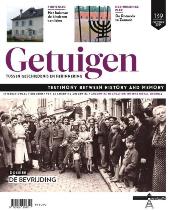
On the occasion of the eightieth anniversary of the liberation of Belgium, We are dedicating a theme issue of our magazine to the country's liberation.
Table of contents (French version)
Table of contents (Dutch version)No. 138 (04/2024) Trials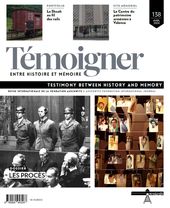
This dossier will deal with trials that have provided a legal answer to a demand for justice. Several cases will be addressed ranging from Istanbul and the Nuremberg Doctors' trial to the German policemen of the Brussels Jewish section and the gacaca trials in Rwanda.
Table of contents (Dutch version)
Table of contents (French version)No. 137 (10/2023) Children's Literature in Light of the Holocaust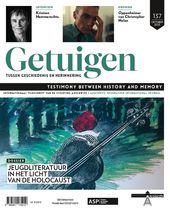
In France and Belgium, research into the relationship between children's literature and the Holocaust is rare, in contrast to the phenomenal attention in America (everyone knows Art Spiegelman's Maus) and in other English-speaking countries. Yet children's books depicting the Holocaust in words and pictures have been steadily gaining ground in post-war France and Belgium. While literary criticism and research still seem to be in their infancy, this dossier will show that critical analysis of this corpus is highly relevant for the future.
Table of contents (Dutch version)
Table of contents (French version)No. 136 (04/2023) The Executioners
The executioner has always fascinated and frightened. The perpetrators of mass crimes are those who carry out, facilitate or order the annihilation of a specific group. Issue 100 of Testimony: Between History and Memory, published in September 2008, examined the Nazi executioners. This dossier offers readers a historical and criminological approach to other genocides of the 20th century.
Table of contents (Dutch version)
Table of contents (French version)No. 135 (10/2022) Disobedience
This issue looks at the concept of disobedience in wartime. While the concept of civil disobedience may seem familiar in these times of endemic protest, there was a time when obedience was the rule. In a military context, disobedience was frequently followed by deadly consequences. This dossier focuses on three cases from the First World War and one from the Algerian War (1954-1962).
Table of contents (Dutch version)
Table of contents (French version)No. 134 (04/2022) The Killing of the ‘Useless’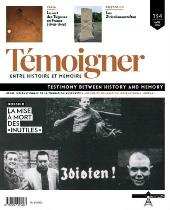
During the Second World War, the Nazi regime didn't just try to destroy the Jewish "race", which it considered dangerous. Before implementing the Final Solution, the Nazis massacred those who didn't fit in with their eugenic racial ideology and whom they considered inferior. In this dossier, we focus on the mentally and physically handicapped, systematic victims of Nazi pseudo-medical madness throughout the world conflict.
Table of contents (Dutch version)
Table of contents (French version)No. 133 (10/2021) 1918-1938: The politicisation of music in Europe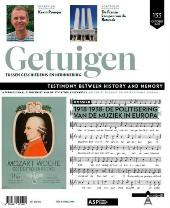
1918-1938: The politicisation of music in Europe
This dossier looks at the instrumentalisation of music by the political world between the wars. The cases are numerous and shed light on the way in which political propaganda was propagated in European musical culture.
Table of contents (Dutch version)
Table of contents (French version)No. 132 (04/2021) AKTION REINHARDT and AKTION ERNTEFEST
AKTION REINHARDT and AKTION ERNTEFEST
The Aktion Reinhardt saw approximately 1.8 million Polish Jews perish in the gas chambers of Bełżec, Sobibór, Treblinka and Majdanek between March 1942 and November 1943. The Jews who ‘escaped’ the gas chambers were shot in Majdanek, Trawniki and Poniatowa on 3 and 4 November 1943 during Aktion Erntefest. The dossier we are proposing takes stock of current research on the Aktion Reinhardt. This historical event has experienced a resurgence of interest among historians of the Shoah over the last fifteen years, thanks, among other things, to archaeological advances at the various sites concerned. We have come a long way since Yithzak Arad's pioneering work in 1987: Belzec, Sobibor, Treblinka: the Operation Reinhard Death Camps. The dossier highlights different perspectives to discuss current research related to the issue. It addresses the erasure of traces, the sociological perspectives of the executioners, the excavation of extermination sites and the most recent historiography.
Table of contents and abstracts (Dutch version)
Table of contents and abstracts (French version)No. 131 (10/2020) Historiography of the Second World War in the Far East
Historiography of the Second World War in the Far East
For many people, 8 May 1945 and the surrender of Nazi Germany is the final chapter of the Second World War. However, it is often forgotten that the months between May and September 1945 were decisive for the future of the world, as fierce fighting continued in the Pacific between the United States and the Japanese Empire until the latter’s unconditional surrender on 2 September 1945, the actual date of the end of the Second World War.Table of contents and abstracts (Dutch version)
Table of contents and abstracts (French version)No. 130 (04/2020) Reception of the Shoah and mentalities in Jewish and Christian circles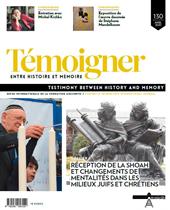
Reception of the Shoah and mentalities in Jewish and Christian circles
The reception of the Shoah has become, for all of humanity, a place of questioning and awareness. This dossier will aim to establish and evaluate the modalities and challenges of the transmission of the Shoah and to measure the resulting changes in identities and mentalities. What were the Catholic views on Judaism before and during the Shoah? What Jewish liturgies and interreligious rites exist for the commemoration of the Shoah in Israel and the United States? The evolution of mentalities in the Jewish world in relation to the Shoah will also be exposed through the analysis of the so-called Bitburg controversy, triggered by the visit of the American President, Ronald Reagan, to the German military cemetery of Bitburg (FRG) in May 1985. The Auschwitz Carmel affair (1985-1993) finally reveals the involvement of the Belgian and French Churches in the resolution of the conflict and is undoubtedly a key stage in the Church's 'teaching of esteem' with regard to the Jews. The historical answers provided in this dossier to the question of the Shoah may be decisive for the survival of Judaism and the relationship between Judaism and Christianity.
Table of contents and abstracts (Dutch version)
Table of contents and abstracts (French version)No. 129 (10/2019) Recognition of victims
Recognition of victims
In recent decades, the idea has gained ground that victims of mass crimes deserve recognition. This has become an essential category of our memorial culture. This dossier aims to take stock of this issue by looking at the broad spectrum of measures to ensure recognition, from simple remembrance to targeted judicial interventions, and by recalling the growing importance of the victim in international criminal justice. It returns to the problematic aspects of recognition when it leads to competition among victims.
Table of contents and abstracts (Dutch version)
Table of contents and abstracts (French version)No. 128 (04/2019) 25 years on, how to remember the Tutsi genocide
Kwibuka [Remember]. 25 years on, how to remember the Tutsi genocide
April 1994. Images of mutilated bodies are projected on European screens, originating from Rwanda. 25 years later, we remember.Table of contents and abstracts (Dutch version)
Table of contents and abstracts (French version)No. 127 (10/2018) Perpetuation of violence after 1918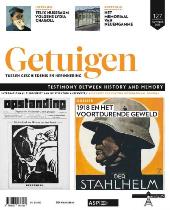
Perpetuation of violence after 1918
One hundred years ago, the First World War ended in November 1918. After four years of bloodshed, peace returns to Europe. At least, that was the impression of the victors at the time, and today it is also the impression of the commemorators who celebrate its centenary. The historical reality is more complex. At least until 1923, violence continued in the form of revolutions and counter-revolutions, wars and civil wars. The spirits also remain in the grip of violence on both the left and the right. The dossier proposes to define the contours of this Europe so strongly marked by the Great War, by evoking the culture of violence established by it and which, finally, degenerated into the total explosion of the Second World War.
No. 126 (04/2018) Questions about the future of remembrance work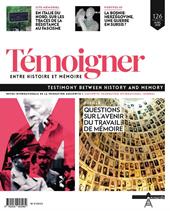
Questions about the future of remembrance work
On 20 and 21 January 2017, the seminar ‘Questions on the future of remembrance work’ was held in Esch-sur-Alzette, Grand Duchy of Luxembourg. The five articles in this dossier taken from the conference proceedings attempt to answer the following questions: How can we build a critical memory of the Shoah, free of myths and national fragmentation? How do we anticipate the absence of direct witnesses? In the future, who transmits what, and how?
No. 125 (10/2017) Persecution of homosexuals by the Nazis
Persecution of homosexuals by the Nazis
Historical knowledge of the Nazi persecution of homosexuals and their deportation has made significant progress in recent years due to the increase in research on the subject. In this dossier, recognised researchers as well as young doctoral and PhD students take the floor. The insights they provide concern both the question of the singular destiny of homosexual men and women during the Second World War and the way in which the memory of the homosexual victims of Nazism has evolved since the end of that war.
No. 124 (04/2017) Music in the camps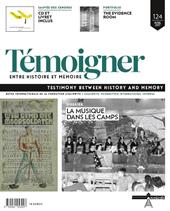
Music in the camps
Music was an integral part of the concentration camp world, Nazi and otherwise. What kind of music was composed and performed, and what exactly was its role in the camps? A factor of survival and resistance for the prisoners, a way for them to express their hope and their humanity - or, on the contrary, an instrument of oppression exploited by the executioners? What is the function of music in the work of memory following the experience of extreme violence and suffering? This dossier proposes to explore these issues.
No. 123 (10/2016) Translating Memory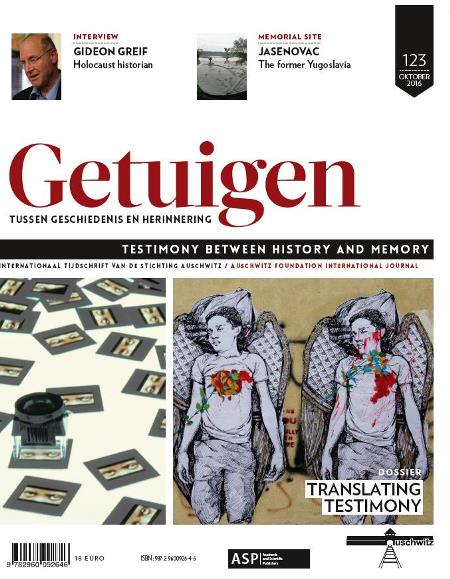
Translating Memory
Presentation of the dossier: What is the relationship between testimony, defined as a more or less ritualized firstperson account of political violence, and translation? Correspondingly, how does the translator position herself towards the witness? Can the translator be, or become, a witness? How, when and why are testimonies translated? Which linguistic and discursive strategies do translators resort to when faced with ethically challenging texts? Which role do they play exactly in the transmission of the historical knowledge, cultural values or social critique conveyed by the testimony? Does translation weaken or rather reinforce the relevance and impact of the original statement? How important is translation in literary, political and institutional settings? Do these specific settings determine translation practice in significant ways? To which extent can subsequent processes of transcription, editing, translation and archiving affect the source text? And how accurate are the boundaries we draw to distinguish witnessing from translating, documentary from literary testimony, the original from its translation? These are the main questions we intend to explore in our dossier.
No. 122 (04/2016) Revisionism and negationism
Revisionism and negationism
Strictly speaking, Holocaust denial is the ‘doctrine denying the reality of the Nazi genocide of the Jews, including the existence of the gas chambers’; by extension, the term refers to the denial of other genocides and crimes against humanity. The literature on Holocaust denial is extensive. There are studies on the subject in many countries as well as biographies of deniers. The argumentative and rhetorical strategies of the deniers have been widely deciphered. Websites systematically dismantle their fallacies. While there is no shortage of reliable information on the phenomenon, it is essential to return to it again and again, for several reasons.
No. 121 (10/2015) Extreme violence on stage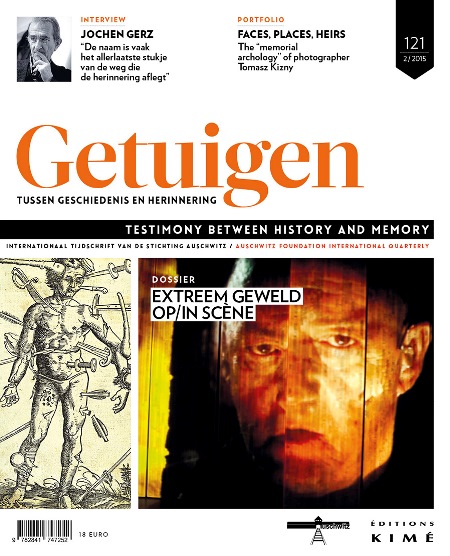
Extreme violence on stage
Extreme violence shows itself. It bursts through the screens. It surfs from one style and medium to another: news reports, documentaries, fiction, arts of all kinds. Yet theatre distinguishes itself from this mêlée all while constantly returning to the subject. Differently. Linked from its origins to the representation of cruelty and having “miraculously” escaped the often sterile polemics on the interdiction (or not)... of representing the Holocaust, it is still with the same youthfulness that theatre deals with extreme violence today, relentlessly pursuing the articulation of ethics and aesthetics.
No. 120 (04/2015) What future is there for the memory of the Armenian genocide?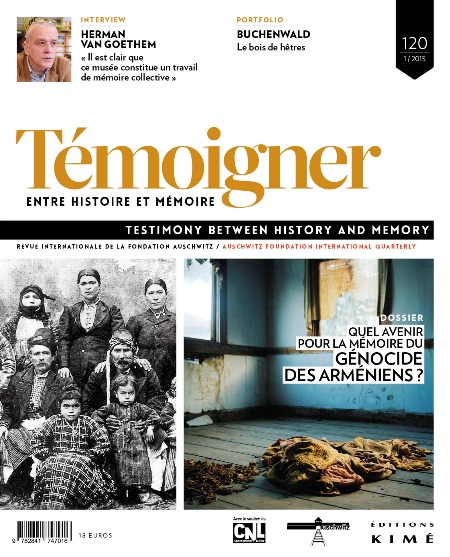
What future is there for the memory of the Armenian genocide?
The 1915 genocide of Turkish Armenians still stirs up numerous debates, controversies, declarations of principle, statements and counter-statements, and even negation. However, as we speak, ties are being established more and more openly, bridges are built and bonds strengthened between the Armenian and Turkish communities. Is reconciliation possible?
No. 119 (12/2014) 70 years ago, Auschwitz. Looking back on Primo Levi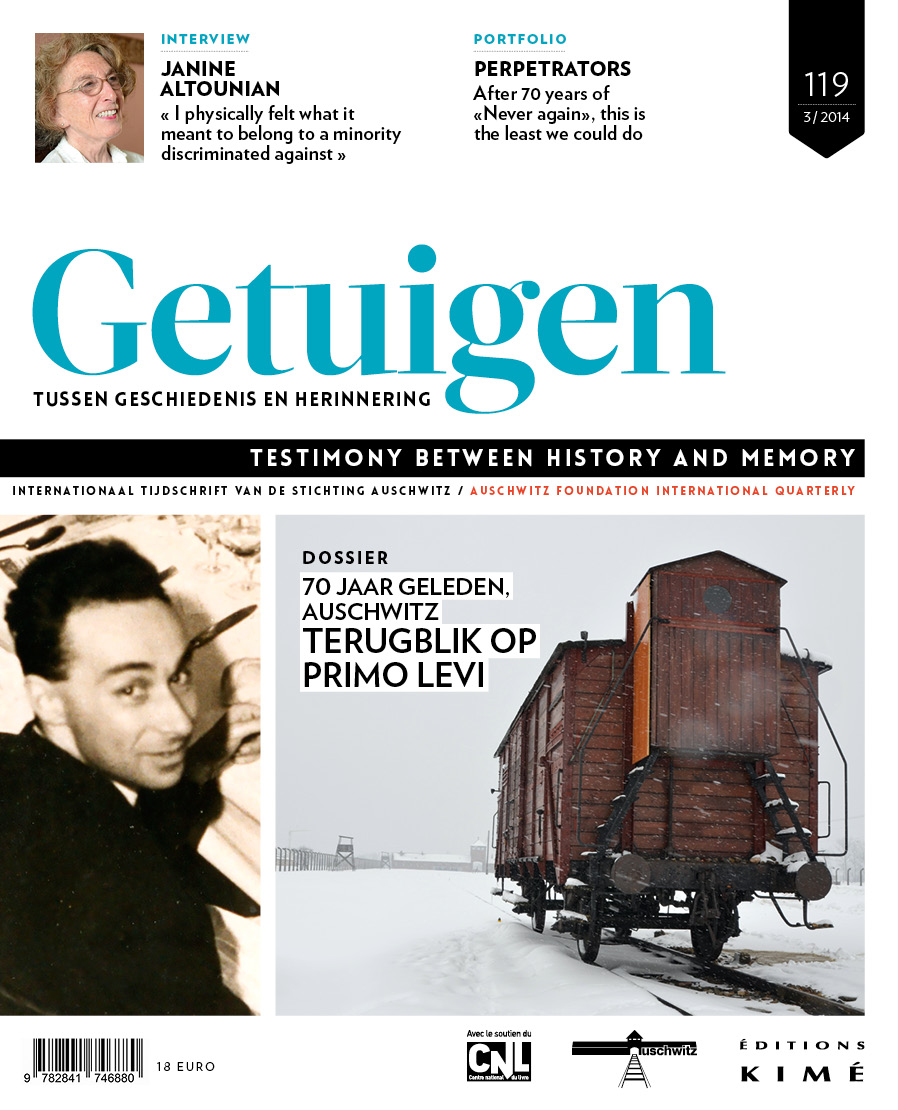
70 years ago, Auschwitz. Looking back on Primo Levi
27 January 1945. Seventy years ago the first soldiers of the Red Army marched into Auschwitz. One might argue that the camp was “liberated” then, but the truth is that neither Auschwitz, nor any of the other Nazi camps, was ever a priority to the Allied Powers. Primo Levi was one of the few survivors who knew how to hide and escape the enforced evacuation of the camps. With this dossier, we want to cast light on the complex figure that Levi was: a Jew, a deportee, a chemists, a witness, and a writer. It sets out to study his oeuvre and his interpretation of the notions of “resistance” and “engagement”, in order to understand how he eventually became a “professional survivor”, as he once described himself.
No. 118 (09/2014) Dictatorship and terror in Argentina, Chile and Uruguay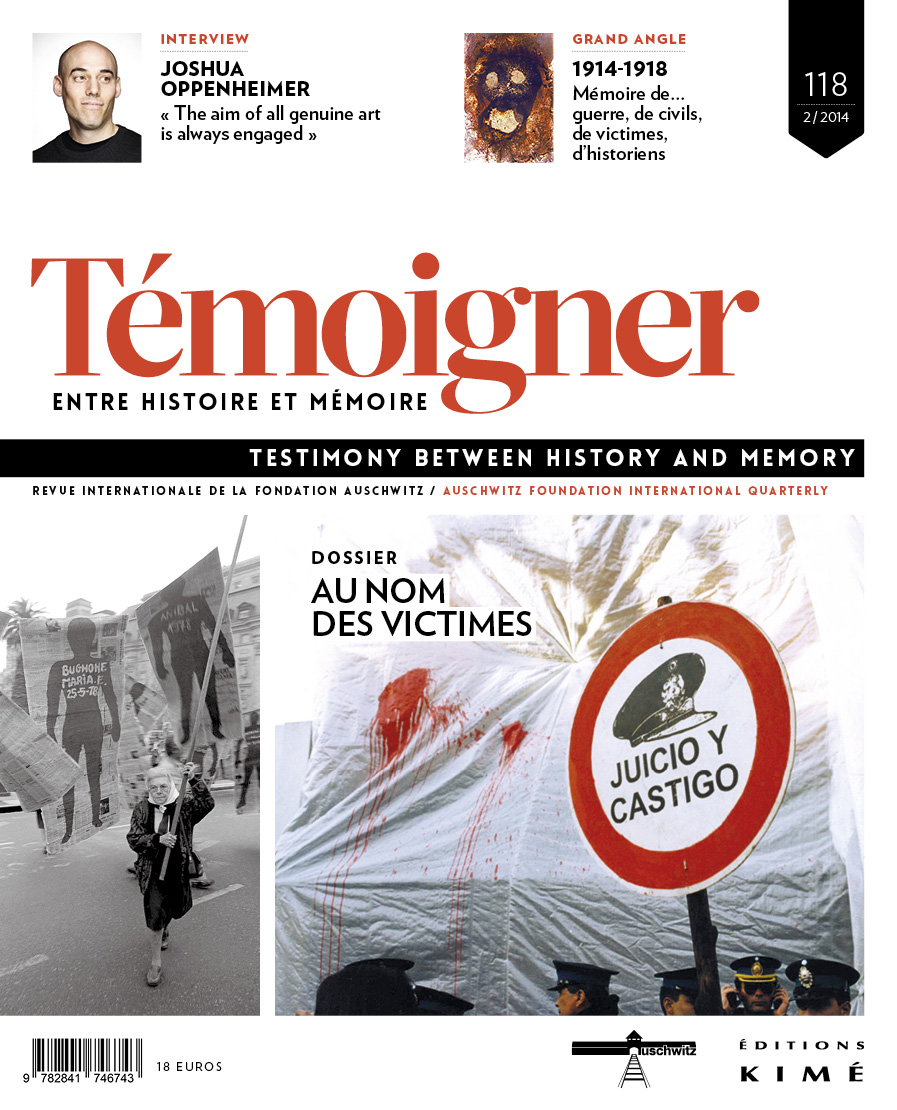
In the name of the victims. Dictatorship and State terror in Argentina, Chile and Uruguay
During the 1970s and 1980s, Argentina, Chile and Uruguay were in the grip of military dictatorships. The process of democratic transition that followed the long period of state terror involved the construction of particular narratives and memories, leading to a reconfiguration of the past. Despite local differences, this process is very much centered at the figure of the victim – a figure the articles in this dossier, collected by Claudia Feld, Luciana Messina and Nadia Tahir, set out to explore.
No. 117 (03/2014) Friends? Enemies? Relationships between memoriesAmis ? Ennemis ? Relations entre mémoires / Vriend of vijand? Hoe herinneringen zich tot elkaar verhouden [Friends? Enemies? Relationships between memories]
Much has been said and written about group memories, limiting their mutual relationships and history to conflicts, “wars”, competitions, or strategies for eclipsing or silencing. These terms have now become the platitudes of a kind of more general doxa about collective and cultural remembrance. This dossier proposes a critical reading of those terms and of that doxa by questioning the emergence, constitution, and inter-relating of different exemplary memories of the major violent episodes of the 20th century. It will address the relationships that those memories can maintain with other memories with which they share, if not the same event, at least similar characteristics and concerns.
No. 116 (09/2013) Memory tripsVoyages mémoriels / Herdenkingsreizen [Memory trips]
Should we fear what has been grouped under the term “memorial tourism”? Or should we take this as a reality of our time? Can any visitor, group or individual, nowadays be absorbed in the category of “tourist”? Or is this category a remote intellectual reduction of a personal experience that everyone is aiming during his visit? The problem appears in a somewhat different light when we think of tours for young people supervised by adults, usually teachers. This dossier gives the floor to historians and teachers with experience in the field.
No. 115 (03/2013) Memory construction in SpainL’Espagne en construction mémorielle / Spanje en de opbouw van de gedachtenis [Memory construction in Spain]
This dossier’s objective is to provide a benchmark for understanding the plural identities and relationships between memories and representation forms in contemporary Spain. Indeed, it is necessary today to take a fresh look not only on the stratified memories of the civil war, exile and the Franco repression, but also on the reception of other memories such as that of the Holocaust, and to propose new readings. We propose to highlight the conflicting or fruitful tensions between official actions, initiatives of associations and of artistic events.
No. 114 (12/2012) Memorial SitesSites mémoriels / Gedenkplaatsen [Memorial Sites]
Memorial sites constitute the concrete trace of European remembrance and history of the twentieth century. But what do they look like today? Exhibition and conservation criteria have changed during the last ten to fifteen years, like advances in historical research have changed the way we read and reconstruct past events. This is not only due to the fact that we have moved from a past history written by witnesses to a history written by professional historians. A new consciousness has emerged concerning transmission methods (memory education), and archeology has strengthened historical research. We tore off the veil of ideology that often influenced and prescribed the way we imagined permanent exhibitions, conservation and visits. Can we say we have entered a new era in memory transmission? It remains, in many ways, an open bet on the present and the future.
No. 113 (09/2012) The Taboos of German HistoryLes tabous de l'histoire allemande / De taboes van de Duitse geschiedenis The Taboos of German History]
The most painful or ambiguous periods in twentieth-century German history are characterized by numerous taboos, expressed in literature, photography and film as so many “returns of the repressed”. These studies focus in part on problems of antisemitism, and thus on the relationship of German-speaking societies to the Shoah. They also examine the way in which those societies confronted the violence they suffered, such as bombing, fleeing from the Red Army and the expulsions, and mass rapes.
No. 112 (06/2012) Children of the Spanish Civil WarLes enfants de la Guerre d'Espagne. Expériences et représentations culturelles / De kinderen van de Spaanse Burgeroorlog. Ervaringen en culturele voorstellingen [Children of the Spanish Civil War: Experiences and Cultural Representations]
The dossier in this issue deals with the experiences and cultural representations of childhood during the Spanish Civil War. It aims to help towards a better understanding of that conflict, which tore apart a population living on the same territory, by confronting the experiences of Spanish children who lived through it – as expressed in various forms during or after the war – with representations of those same children, particularly those coming from adults.
No. 111 (12/ 2011) Dangerous Game between Art and PropagandaArt & propagande : jeux inter-dits / Gevaarlijk spel tussen kunst en propaganda [Dangerous Game between Art and Propaganda]
Since the media came into existence, political institutions from political parties to governments have used them to promote their image, in order to win the support of the public they addressed. Authoritarian powers use the media as a means of consolidating their domination. But how can artists take part in propaganda, whose purposes are the opposite of those generally attributed to art? Does that mean setting aside their vocation, or do they themselves distort that vocation?
No. 110 (10/2011) Displacements, Deportations, ExileDéplacements, déportations, exils / Volksverhuizingen, deportaties, verbanningen [Displacements, Deportations, Exile]
States and criminal groups exploit population displacements to isolate or get rid of certain populations. In addition to being denied their normal rights, these populations lose visibility and are deprived of their reference points and social frameworks. In this way it is possible to make them the victims of constraints (deterritorialization, forced labor…) or violence (famine, massacres genocide…). These developments have spread on an unprecedented scale since the First World War and continue to grow worldwide. But there is also a dimension of remembrance to this reality: memories of these displacements are now being expressed in literature, and in exhibitions and museums. This dossier examines the contemporary double aspect of history and memory.
No. 109 (03/ 2011) 20th Century Wars and Genocides in Graphic Novels and Comic StripsLa bande dessinée dans l'orbe des guerres et des génocides du XXe siècle / Twintigste-eeuwse oorlogen en genociden in het stripverhaal [Twentieth Century Wars and Genocides as Portrayed in Graphic Novels and Comic Strips]
No. 108 (09/2010) How Documentaries Handle HistoryLe traitement de l'histoire dans les documentaires filmiques / De behandeling van de geschiedenis in de documentaire film [How Documentaries Handle History]
No. 104 (09/2009) Anti-fascism Revisited: History, Ideology, RemembranceL'Antifascisme revisité. Histoire – Idéologie – Mémoire / Nogmaals antifascisme. Geschiedenis, ideologie, gedachtenis [Anti-fascism Revisited: History, Ideology, Remembrance]
No. 103 (06/ 2009) Nazi Crimes and Genocides on the ScreenCrimes et génocides nazis à l'écran / Nazimisdaden en genociden op het scherm [Nazi Crimes and Genocides on the Screen]
No. 102 (03/ 2009) The Portrayal of Political Criminals in Films, Plays, Literature...Criminels politiques en représentation. Arts, cinéma, théâtre, littérature, médias / De representatie van politieke misdadigers. Kunst, film, theater, literatuur, media [The Portrayal of Political Criminals in Films and Plays, in Literature and in the Media]
No. 101 (12/2008) How to Educate, How to Remember?Quelle pédagogie, pour quelle(s) mémoire(s) ? / Welke pedagogie, voor welke herinnering(en)? [How to Educate, How to Remember?]
No. 100 (09/2008) Questions about the “Executioners”Questions de « bourreaux » / De kwestie van de “beul” [Questions about the “Executioners”]
Contact
Auschwitz Foundation – Remembrance of Auschwitz
Rue aux Laines 17 box 50 – B-1000 Brussels +32 (0)2 512 79 98
+32 (0)2 512 79 98 info@auschwitz.be
info@auschwitz.be
BCE/KBO Auschwitz Foundation: 0876787354
BCE/KBO Remembrance of Auschwitz: 0420667323
Office open from Monday to Friday 9:30am to 4:30pm.
Visit only by appointment.
![]()
![]()
![]()
![]()
![]()
Become a member
To become a member of Remembrance of Auschwitz ASBL, please contact us and transfer the sum of €50.00 to our account IBAN: BE55 3100 7805 1744 – BIC: BBRUBEBB with the communication: ‘Membership fee 2025’. The membership includes two issues of 2025 of our scientific journal.
DONATIONS
Donations of €40.00 or more (in one or more instalments) qualify for tax exemption for Belgian taxpayers.
In communication, please specify that it is a ‘Donation’ and mention your National Number which is required since 2024 to benefit from the tax exemption.
Subscribe
Error : Please select some lists in your AcyMailing module configuration for the field "Automatically subscribe to" and make sure the selected lists are enabled









































